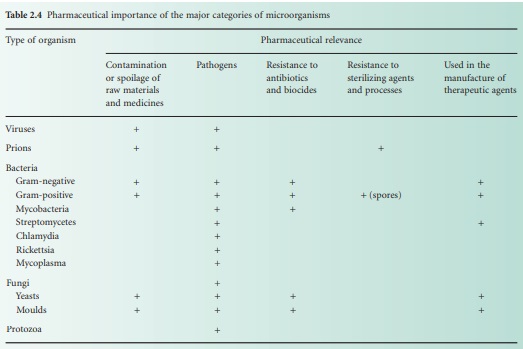Pharmaceutical Importance of the Major Categories of Microorganisms
| Home | | Pharmaceutical Microbiology | | Pharmaceutical Microbiology |Chapter: Pharmaceutical Microbiology : Fundamental features of microbiology
Like bacteria, fungi are able to form spores that survive drying, so they too arise commonly as contaminants of manufactured medicines. However, the degree of resistance presented by the spores is usually less than that exhibited by bacteria, and fungi.....
PHARMACEUTICAL IMPORTANCE OF THE MAJOR
CATEGORIES OF MICROORGANISMS

Table
2.4 indicates the ways in which the different types of microorganism are
considered relevant in pharmacy. The importance of viruses derives exclusively
from their pathogenic potential, and because of their lack of intrinsic
metabolism they are not susceptible to antibiotics. Partly for these reasons,
viral infections are among the most dangerous and difficult to cure, and of all
the categories of microorganism, only viruses appear in (the most serious)
Hazard Category 4 as classified by the Advisory Committee on Dangerous
Pathogens. Because they are not free living, viruses are incapable of growing
on manufactured medicines or raw materials, so they do not cause product
spoilage, and they have no synthetic capabilities that can be exploited in
medicines manufacture. Viruses are relatively easy to destroy by heat, radiation
or toxic chemicals, so they do not represent a problem from this perspective.
In this, they contrast with prions; although some authorities would question
the categorization of these infectious agents as microorganisms, they are
included here because of their undoubted ability to cause, as yet incurable,
fatal disease, and their extreme resistance to lethal agents. Pharmacists and
healthcare personnel in general should be aware of the ability of prions to
easily withstand sterilizing conditions that would be satisfactory for the
destruction of all other categories of infectious agent.
There
are examples of bacteria that are important in each of the different ways
indicated by the column headings of Table 2.4. Many of the medically and
pharmaceutically important bacteria are pathogens, and some of these pathogens
are of longstanding notoriety as a result of their ability to resist the
activity of antibiotics and biocides (disinfectants, antiseptics and preservatives).
In addition to these long-established resistant organisms, other bacteria have
given more recent cause for concern including methicillin-resistant Staphylococcus aureus (MRSA), vancomycin-resistant
enterococci (VSE) and multiply resistant Mycobacterium
tuberculosis. While penicillin and cephalosporin antibiotics are produced
by fungal species, the majority of the other categories of clinically important
antibiotics are produced by species of bacteria, notably streptomycetes. In addition,
a variety of bacteria are exploited commercially in the manufacture of other
medicines including steroids, enzymes and carbohydrates. The ability of
bacteria to grow on diverse substrates ensures that their potential as agents
of spoilage in manufactured medicines and raw materials is well recognized, and
the ability of many species to survive drying means that they survive well in
dust and so become important as contaminants of manufactured medicines. The
ability to survive not only in dry conditions but in other adverse environments
(heat, radiation, toxic chemicals) is well exemplified by bacterial spores, and
their pre-eminence at or near the top of the ‘league table’ of resistance to
lethal agents has resulted in spores acting as the indicator organisms that
have to be eliminated in most sterilization processes .
Like
bacteria, fungi are able to form spores that survive drying, so they too arise
commonly as contaminants of manufactured medicines. However, the degree of
resistance presented by the spores is usually less than that exhibited by
bacteria, and fungi do not represent a sterilization problem. Fungi do not
generally create a significant infection hazard either; relatively few fungal
species are considered major pathogens for animals that possess a fully
functional immune system. There are, however, several fungi which, while
representing little threat to immuno-competent individuals, are nevertheless
capable of initiating an infection in persons with impaired immune function; the
term ‘opportunist pathogens’ is used to describe microorganisms (of all types)
possessing this characteristic. In this context it is worth noting that the immune-comopromised
represent an increasingly large group of patients, and this is not just because
of HIV/AIDS. Several other conditions or drug treatments impair immune
function, e.g. congenital immunodeficiency, cancer (particularly leukaemia),
radiotherapy and chemotherapy, the use of systemic corticosteroids and
immunosuppressive drugs (often following tissue or organ transplants), severe
burns and malnutrition.
Protozoa
are of significance largely owing to the pathogenic potential of a few species.
Because protozoa do not possess cell walls they do not survive drying well
(unless in the form of cysts), so they are not a problem in the manufacturing
environment—and even the encysted forms do not display resistance to
sterilizing processes to match that of bacterial spores. It should be noted
that protozoal infections are not currently a major problem to human health in
temperate climates, although they are more troublesome in veterinary medicine
and in the tropics. There are concerns that the geographical ranges of
protozoal infections such as malaria may extend substantially if current fears
about global warming translate into reality.
Related Topics
